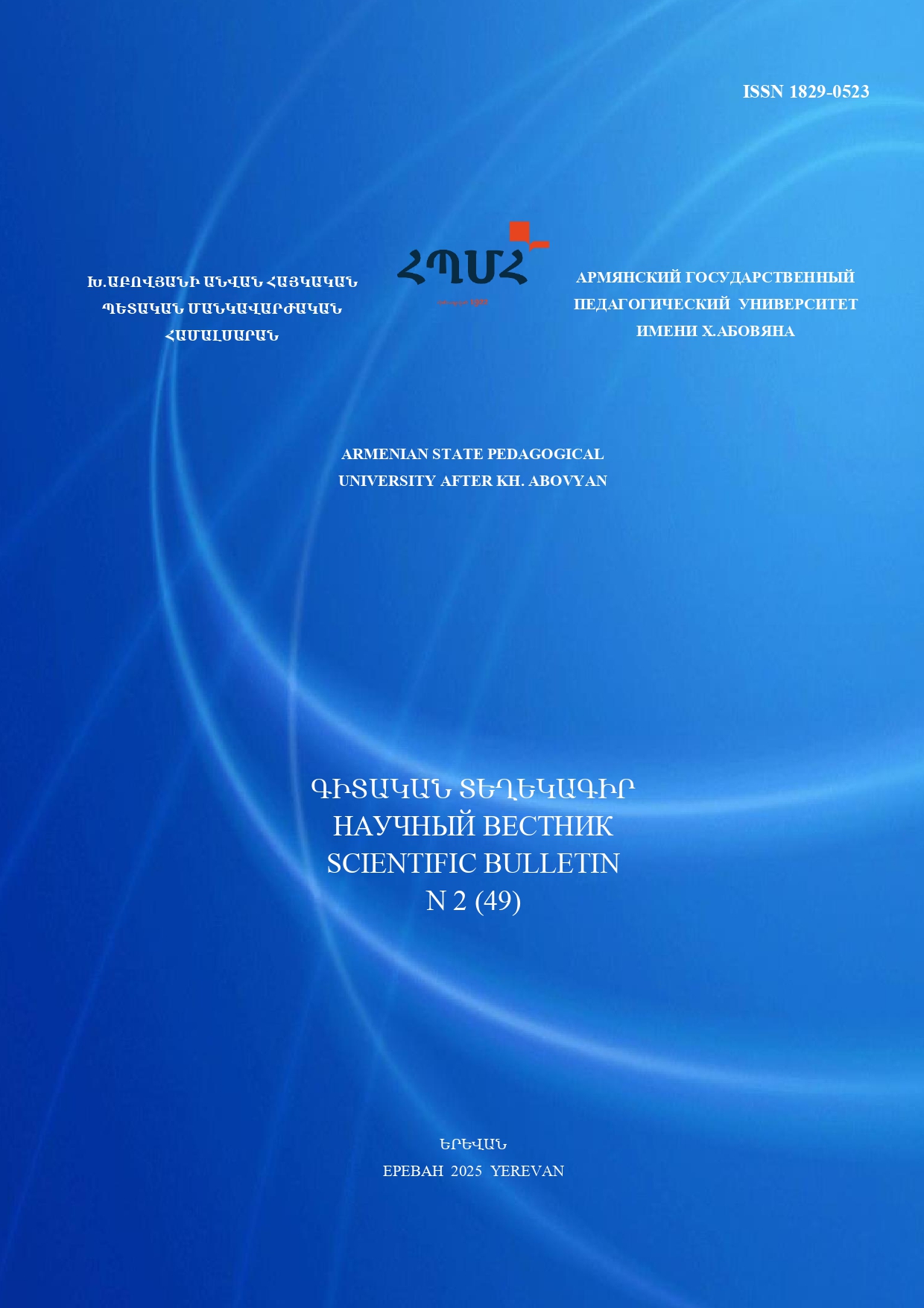MEDIEVAL TRAVELOGUES WITH CROSS-CULTURAL VALUE
DOI:
https://doi.org/10.24234/scientific.v2i49.216Keywords:
travelogues, Christian shrines, Rome, Asia, EuropeAbstract
The article focuses on the travels of two Armenian clergymen of the Middle Ages to famous Christian shrines in Europe.
The first one - Martiros Erzincatsi, traveled to Rome, met the Pope, visited the main monasteries of different European countries and recorded his impressions.
The second one was Simeon Lehatsi, who traveled from Poland to Istanbul, from there to Rome and Venice, also visited Egypt and left a detailed description of the countries and places he saw.
Today, these travelogues have a unique historical and cultural value. Their cognitive nature is relevant and gives a clear idea of why, from ancient times to the present day, knowledge of the world and the rapprochement of cultures have had universal value. Such directions actually became the basis for the recognition and rapprochement of cultures of different peoples and contributed to the cultural progress of different countries.
In this context, we can mention Alexander the Great, who created the phenomenon of Hellenism, which contributed to the development of painting, sculpture, architecture, theater, literature and culture and other fields in different countries of the world.
The same can be said about the art of the Christian period, about the manifestations of which the two aforementioned Armenian clergymen report valuable facts, urging them to take from Europe everything that is progressive and promotes a dialogue of cultures.
These clergymen were also, in a sense, brave and inquisitive people, true adherents of the goal, who, as they themselves testify, overcame many difficulties and achieved their goals.
References
Abovian Kh. (1956). Complete Works in Eight Volumes, Vol. VII, Yerevan, Academy of Sciences of the Armenian SSR Publishing, 523 pages (in Armenian).
Agathangelos (1989). History of the Armenians, translated and annotated by Aram Ter-Khvedonyan, Yerevan, Yerevan State University Publishing, 551 pages (in Armenian).
Biographical Encyclopedia (2005). Who is Who, Armenians: Vol. I, Yerevan, Armenian Encyclopedia Publishing, 726 pages (in Armenian).
Biographical Encyclopedia (2007). Who is Who, Armenians: Vol. II, Yerevan, Armenian Encyclopedia Publishing, 733 pages (in Armenian).
Brockhaus F.A., Efron I.A. (2012). Illustrated Encyclopedic Dictionary, Modern version, Moscow, EKSMO 957 p. (in Russ.).
Bunin N.A. (1988). Collected Works in Four Volumes, Vol. 1, Moscow, Pravda Publishing House, 478 p. (in Russ.).
Chantre B. (1893). A travers l’ Armenie Russe, Paris, “Hachette”
Chrestomathy of the History of the Armenian People (1981) Vol. 1, From Ancient Times to the Mid-9th Century, Yerevan, Yerevan State University Publishing, 943 pages (in Armenian).
Dolukhanyan A.G. (2021). Meetings with Russian Literature in Armenia, Collection of Articles, edited by Doctor of Philological Sciences, Professor M.D. Amirkhanyan, Yerevan, Publishing House “HT Print”, 83 p. (in Russ.).
Dolukhanyan A. (2003). Victor Langlois, an Armenian Studies Scholar, Yerevan, "Lusakn" Publishing, 118 pages (in Armenian).
Dolukhanyan A. (2014). Saint-Martin: The Founder of French Armenian Studies, Yerevan, "Zangak" Publishing, 337 pages (in Armenian).
Gumilev L. (2017). Encyclopedia, Moscow, Publishing House “Khudozhestvennaya literatura”, 804 p., (in Russ.).
Hayrenik Magazine, (1923, December). Boston, 144 pages (in Armenian).
Hayrenik Magazine, (1924, January) Boston, 144 pages (in Armenian).
Hermet A., Di Dezio P.K.R. (2000). Venice of the Armenians, Yerevan, Murcia Sahak Partev, 299 pages (in Armenian).
Information Bulletin (1965). Public Sciences of the Academy of Sciences of the Armenian SSR, N6, Yerevan, Academy of Sciences of the Armenian SSR Publishing (in Armenian).
Jrbashyan Ed., Makchanyan H. (1972). Literary Dictionary, General Editing by Prof. Ed. Jrbashyan, Yerevan, "Lus" Publishing, 328 pages (in Armenian).
Isahakyan Av. (1973). Collected Works in Six Volumes, Vol. I, Yerevan, "Hayastan" Publishing, 463 pages (in Armenian).
Journal Asiatique (1826, Décembre). Paris.
Langlois V. (1855). Voyage à Sis, capitale de l’Armenie au moyen age, Paris.
List of Manuscripts of the Matenadaran after Mesrop Mashtots (2010). Vol. A, Compiled by O. Malkhasyants St., Armenian Explanatory Dictionary, Vol. III, Yerevan, Yerevan State University Publishing, 614 pages (in Armenian).
Movses Khorenatsi (1981). History of the Armenians, translated and commented by St. Malkhasyan, Yerevan, Yerevan State University Publishing, 587 pages (in Armenian).
Nouveau petit Larousse illustré (1932). Paris librairie Larousse, 1759p.
Petit Robert-2 (1988) Dioctionnaire universel des noms propres, Paris, Dictionnaires le Robert, 1952 p.
Plutarch (1987). Works, Yerevan, "Hayastan" Publishing, 793 pages (in Armenian).
Porter Ker R. (1821). Travels in Georgia, Persia, Armenia, Ancient Babylonia during the years 1817, 1818, 1819 and 1820, in two volumes, v.I, London, Longman, 882 p.
Ridout R. and Witting Cl. (1981). English Proverbs Explained, London and Sidney, Pan Books, 223 p.
Simeon Lehatsi (1997). Itinerary, Translation, Introduction, and Commentary by Arshak Madoyan, Yerevan, "Nairi" Publishing, 250 pages (in Armenian).
The Holy Quran (2006). Armenian translation and annotations by Eduard Khakverdyan, Yerevan, "Hayastan" Publishing, 1223 pages (in Armenian).
The Reader՚s Companion to World Literature (2002). second edition, London, Signet classics, 805 p.
Vorts (Trial) (1881, May-June). Tbilisi (in Armenian).
Yeganyan, A. Zeytunyan, P. Antabyan (1965). Yerevan, Academy of Sciences of the Armenian SSR Publishing, 1634 pages (in Armenian).
Downloads
Published
Issue
Section
License
Copyright (c) 2025 AELITA DOLUKHANYAN; VLADIMIR KARAPETYAN, ASHOT GALSTYAN, NAIRA KHACHATRYAN, RUZAN DOLUKHANYAN, MARIANNA AMIRAGHYAN

This work is licensed under a Creative Commons Attribution-NonCommercial 4.0 International License.




